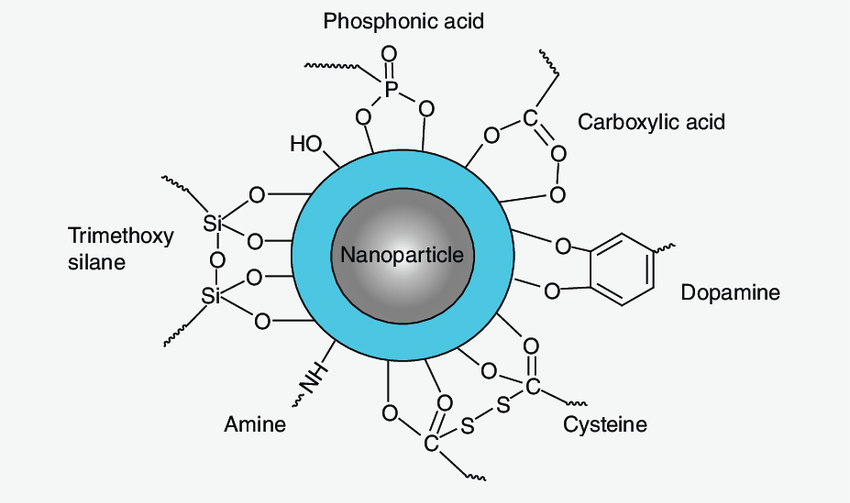Surface Functionalization: Tailoring Nanomaterial Properties for Diverse Applications
What is Surface Functionalization?
Surface functionalization is a process of modifying the surface of a material by incorporating functional groups or molecules to alter its properties and interactions with the surrounding environment. In the context of nanotechnology, surface functionalization plays a crucial role in tailoring the properties of nanomaterials for specific applications, such as drug delivery, biosensing, catalysis, and nanocomposites.

Techniques for Surface Functionalization
Several techniques are employed for surface functionalization of nanomaterials, depending on the desired properties and the nature of the material. Some common techniques include:
Covalent Functionalization
Covalent functionalization involves the formation of chemical bonds between the functional groups and the surface of the nanomaterial. This approach provides a stable and robust modification of the surface properties. Examples of covalent functionalization include silanization, where organosilane molecules are attached to the surface of silica nanoparticles, and the attachment of thiol groups to gold nanoparticles.
Non-Covalent Functionalization
Non-covalent functionalization relies on weaker interactions, such as van der Waals forces, hydrogen bonding, or electrostatic interactions, to adsorb molecules onto the surface of the nanomaterial. This approach is reversible and allows for the dynamic exchange of functional groups. Examples include the adsorption of surfactants or polymers onto the surface of nanoparticles to improve their dispersibility in solvents.
Ligand Exchange
Ligand exchange involves the replacement of existing surface ligands with new functional groups. This technique is commonly used for nanoparticles synthesized with capping agents to stabilize their growth. By exchanging the capping agents with desired functional groups, the surface properties of the nanoparticles can be tailored for specific applications.
Applications of Surface Functionalization
Surface functionalization of nanomaterials enables a wide range of applications across various fields:
Biomedical Applications
Surface functionalization plays a vital role in the development of nanomaterials for biomedical applications, such as targeted drug delivery and biosensing. By attaching targeting ligands, such as antibodies or peptides, to the surface of nanoparticles, they can selectively bind to specific cells or tissues. Additionally, the attachment of hydrophilic polymers, such as polyethylene glycol (PEG), can improve the biocompatibility and circulation time of nanoparticles in the body.
Catalysis
Surface functionalization can enhance the catalytic properties of nanomaterials by introducing active sites or improving the selectivity towards specific reactions. For example, the functionalization of metal nanoparticles with organic ligands can create catalytic sites for organic synthesis reactions. Moreover, the attachment of enzymes or biomolecules to the surface of nanoparticles can enable biocatalysis for environmentally friendly and sustainable chemical processes.
Sensors and Detectors
Surface functionalization is crucial for the development of highly sensitive and selective sensors and detectors based on nanomaterials. By incorporating receptor molecules or functional groups that interact with specific analytes, nanomaterials can be designed to detect various chemical or biological species. For instance, the functionalization of carbon nanotubes with DNA aptamers enables the detection of specific proteins or small molecules with high sensitivity and specificity.
Nanocomposites
Surface functionalization plays a key role in the fabrication of nanocomposites with enhanced properties. By functionalizing the surface of nanofillers, such as carbon nanotubes or graphene, their dispersion and interfacial interactions with the polymer matrix can be improved. This leads to better load transfer and mechanical reinforcement in the nanocomposite. Additionally, surface functionalization can introduce new functionalities, such as electrical conductivity or self-healing properties, to the nanocomposite.
Challenges and Future Perspectives
Despite the significant advancements in surface functionalization techniques, several challenges remain. One of the main challenges is the precise control over the density and orientation of functional groups on the surface of nanomaterials. Achieving a homogeneous and reproducible functionalization is crucial for reliable and consistent performance in applications.
Future research in surface functionalization will focus on the development of novel functional groups and molecules with improved stability, selectivity, and biocompatibility. The combination of surface functionalization with other nanomaterial synthesis techniques, such as self-assembly and hierarchical structuring, will enable the creation of multifunctional nanomaterials with tailored properties. Additionally, the integration of computational modeling and machine learning approaches will accelerate the design and optimization of surface functionalization strategies for specific applications.
Further Reading
Chemical Society Reviews, Surface Functionalization of Nanoparticles for Nanomedicine
Frontiers in Molecular Biosciences, Nanoparticle Surface Functionalization: How to Improve Biocompatibility and Cellular Internalization
